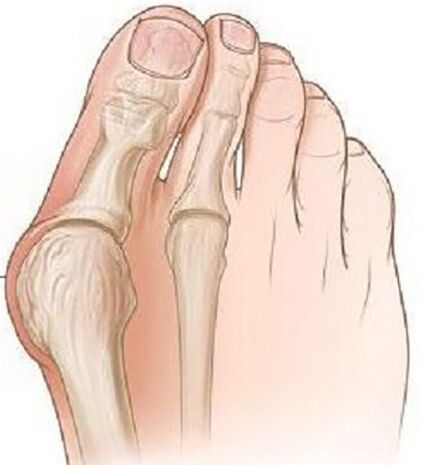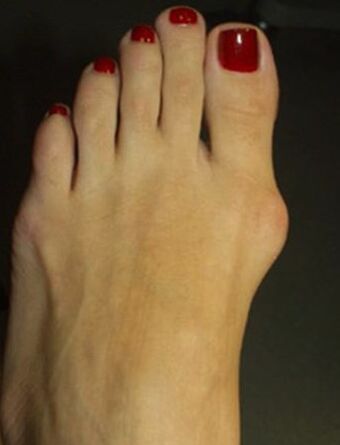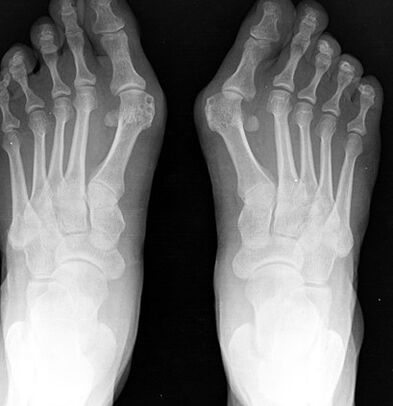The valgus deformation of the thumb of the foot is the most frequent acquired deformation of the foot, which is characterized by the deviation of the thumb towards the outside.
Pathology is bilateral in nature, mainly affects women over 35 years old.In most cases, deformation is accompanied by chronic inflammation of the joint bag and distorting arthritis of the more Netnephalang joints, deviations from prognosis of the first metatarsal bone.

Causes of the disease.Why is it dangerous?
The etiological causes of the gaps of the thumb valgus of the foot have not yet been fully studied.There are several theories of the occurrence:
- Vestigian theory.In the middle of the 19th century, it was believed that only models were subjected to this deformation due to the use of model shoes in hoppers, but during the study, this pathology was found in men who wore flat sole shoes.
- The theory of primary muscle weakness - has been refuted in a detailed study of the problem.
- The theory of the weakness of the ligament system and the lack of aponeurosis of the only - most scientists adhere to this theory.
There are a number of factors leading to the beginnings of this pathology:
- Excess weight increasing the load on the feet.
- Age -related dystrophic changes in the ligament joint apparatus.
- The weeks of heeled shoes are more than 5 cm, narrowed in the toe.
- The existing deformations of the skeleton (scoliosis, deformation valgus of the femoral joints and knees, flat feet).
The danger of pathology lies in the fact that over time, this deformation leads to the deformation of the posture, it is possible to develop dystrophic overruns of the spine, hip and knee due to an incorrect distribution of loading during walking, and injuries of the foot muscles are accompanied by constant pain, which is considerably well-being of a person.
Clinical manifestations
At the start of the disease, the deformation of the valgus does not show itself clinically.Most women are more concerned with the appearance of the increase in the foot-and of the metacarpale-shalanx joint and the explosion of the first finger becomes perceptible.

Over time, the pain occurs, first when you wear narrow shoes and a prolonged walk, and later, the pain begins to be constant, painful.
Due to the poor distribution of the weight, the member, on the first and the second finger on the sole, is formed by Cors, the second finger is lifted, strongly extended, the "Malleus" fingers are formed, which considerably complicates walking.Due to the deterioration of blood circulation and innervation in the anterior part of the foot, osteoarthritis and chronic bursitis are developing.
Diagnosis
- During an objective examination, the classic deformation with the valgus differences of the thumb is visible, the distal part of the foot was extended.In the projection of the head of the first metatarsal bone, there are signs of scholarship - hyperemia and edema of the skin, pain during palpation.
- The radiography of the foot in two projections.The front projection determines the degree of the thumb, the state of the metacarpale-shalanx joint, the degree of displacement of the sesamoid bone, and in the lateral projection, the degree of flat feet is visualized and calculated, which occurs very often with valgus differences in the first finger of the foot.
- Plantography.On the printing of the foot, made on paper, a line is drawn through the center of the heel and between the fourth and third fingers, the external set of the foot is formed figuratively, according to which the presence of the flattening of the foot and sound degree are evaluated.In these patients, a foot or flat feet flattened with the 1st degree is more often detected.
Treatment and prevention
Depending on the severity of the process, conservative or surgical treatment is carried out.
Conservative treatment is carried out at the light stage of the disease, various types of orthopedic soles are used, which are individually selected and bring the distorted finger to the normal position, while the load at the front of the limb is stabilized and distributed.
At the age of the children and the senile, the transverse bandage of the distal limb with a pose between the first and the second finger is used.To reduce pain, hot baths with sea salt and soda are used, radon baths give a good result.
To combat bursitis, local anti-inflammatory gels, compresses with dimyide and lidocaine are used, and with pronounced pain, blocking of novocaine and intra-articular glucocorticoids are used.

Surgical treatment is possible at any stage of the disease, it is carried out under local anesthesia, which reduces the list of contraindications for surgery.
At the 1st stage, cold bone growths are removed on the inner edge of the bone, while it is possible to reduce the pain of the process, but not to prevent the development of deformation in the future.
With a severe deviation from the finger with the presence of flat feet, an osteotomy is made at the base of the bone more of the first finger using a bone blade to reject the finger in the normal position, using a Lavsan ribbon, the transverse ligament of the SEME is formed.After surgery, the leg is closely fixed with a bandage for 4 weeks, it is recommended to use individual orthopedic soles during the year.
The prevention of the disease consists in using comfortable shoes without high heels, the shoes must sit freely on the leg, a narrowed toe should not bring discomfort in the thumb.If there are deformations of the skeleton, it is recommended to undergo preventive examinations in the orthopedicist in order to identify and slow down the progression of the deformation of the thumb valgus.
Consequences and complications
A complication of the process is the development of Deichländer or the "walking" of the foot, which is characterized by acute pain, due to microfissuries in the joints of the appearance of the foot and the tendovaginitis.
Due to the constant inflammatory process and mechanical damage, there is a risk of developing clever bone neoplasms.























